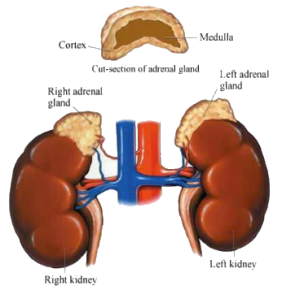 | Glucocorticoid- and Androgen-Secreting Black Adrenocortical Adenomas: Unique Cause of Corticotropin-Independent Cushing Sydrome | |
|
Authors
Satoshi Tanaka, MD, PhD1, Akiyo Tanabe, MD, PhD1, Motohiko Aiba, MD, PhD2, Naomi Hizuka, MD, PhD1, Kazue Takano, MD, PhD1, Jun Zhang, MD3, William F. Young, MD, MSc, Jr.4
1Department of Medicine, Tokyo Women's Medical University, Tokyto, Japan
2Department of Clinical Pathology, Tokyo Women's Medical University Medical Center East, Tokyo, Japan
3Department of Anatomic and Clinical Pathology, Mayo Clinic, Rochester, Minnesota
4Division of Endocrinology, Diabetes, Metabolism, and Nutrition, Mayo Clinic, Rochester, Minnesota
Abstract
Objective: To describe the unique association of corticotropin-independent Cushing syndrome caused by cortisol- and androgen-secreting black adrenal cortical adenomas with myelolipomatous change.
Methods: We report the clinical, laboratory, radiologic, and pathologic findings from 2 patients who presented with androgen excess and typical signs and symptoms of Cushing syndrome.
Results: Endocrine investigations showed high serum cortisol concentrations that lacked diurnal rhythm, undetectable plasma corticotropin concentrations, and absence of serum cortisol suppression after overnight dexamethasone suppression tests. Serum levels of adrenal androgens were elevated. Computed tomography of the abdomen revealed unilateral adrenal masses (largest lesional diameters 4.0 and 3.1 cm). On the basis of the plurihormonal hypersecretion and the imaging characteristics, adrenocortical carcinoma was considered as a possible diagnosis. However, histopathologic analysis in both patients revealed black adrenal cortical adenomas with myelolipomatous change. After surgery, adrenal androgens normalized, and the signs and symptoms of Cushing syndrome and androgen excess resolved. There was no evidence of recurrent disease at last follow-up.
Conclusions: A unique form of corticotropin-independent Cushing syndrome is described: cortisol- and androgen-secreting black adrenal cortical adenomas with myelolipomatous change. Although most patients with corticotropin-independent Cushing syndrome associated with androgen excess prove to have adrenocortical carcinoma, the clinician should be aware of the possibility of benign, black adrenal adenomas in this clinical setting.
Show References
From http://aace.metapress.com/content/yg61xw4671161wg6/



 PDF (1.8 MB)
PDF (1.8 MB)